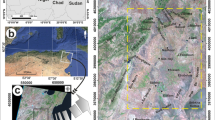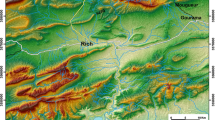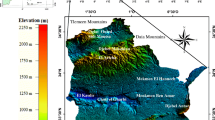Abstract
High local groundwater flow into rock tunnels through the fracture zones is an important factor influencing excavation time and costs. Therefore, detection of geological features for prediction of high local groundwater flow is essential before excavation of tunnels. Observations during excavation suggest that open fractures in the limestone layers of Li3 unit are the main reason for the high water inflow. The limestone thick layers outcrop in form of cliffs constituting the upper parts of the cuesta. Moreover, Li3 unit as a recharge source of the springs has the highest potential for groundwater inflow throughout the tunnel. To reduce the costs and time of field works, remote sensing investigations can be a good solution. The main aim of this study is to present a methodology for digital processing of ASTER satellite imagery data to detect mall-scale fractures of cuesta-forming limestone layers. Experimental results provided for the Long Zagros tunnel show that, fractures in direction of cliff limestone unites can be detected using colour and textural characteristics of the ASTER image. Results also show that, Li3 unite can be detected on the image based on lack of small scale folding, have a vertical outcrop, interruption in edge direction and without clay cover.























Similar content being viewed by others
References
Altindag, R. (2003). Correlation of specific energy with rock brittleness concepts on rock cutting. The Journal of The South African Institute of Mining and Metallurgy.
Bedini, E. (2009). Mapping lithology of the Sarfartoq carbonatite complex, Southern West Greenland, using HyMap maging spectrometer data. Remote Sensing of Environment, 113(6), 1208–1219.
Bihong, F., Yoshiki, N., Xinglin, L., Shinji, T., & Yasuo, A. (2004). Mapping active fault associated with the 2003 Mw 6.6 Bam (SE Iran) earthquake with ASTER 3D images. Original Research Article Remote Sensing of Environment, 92(2), 153–157.
Banerjee S., & Mitra S., 2004. Remote surface mapping using orthophotos and geologic maps draped over digital elevation models: Application to the Sheep Mountain anticline, Wyoming. The American Association of Petroleum Geologists. V. 88, No. 9 P. 1227–1237.
Chorowicz, J., Dhont, D., & Gundogdu, N. (1999). Neotectonics in the Eastern North Anatolian Fault Region (Turkey) advocates crustal extension: mapping from SAR ERS imagery and digital elevation model. Journal of Structural Geology, 21, 511–532.
Drury, S. A. (1987). Image interpretation in geology. London:Allen and Unwin.
Dehghani, M., Durocher,C., & Gingerich, J., (2004) Alteration extraction using remote sensing data for mineral exploration, map India. http://www.gis development.com
Florinsky, I. V. (1998). Combined analysis of digital terrain models and remotely sensed data in landscape investigations. Progress in Physical Geography, 22, 33–60.
Fujisada, H., (1995). Design and performance of ASTER instrument. Proceedings of SPIE, the International Society for Optical Engineering, 2583, 16–25.
Gitelson, A. A., Kaufman, Y. J., & Merzlyak, M. N. (1996). Use of a green channel in remote sensing of global vegetation from EOS-MODIS. Remote Sensing of Environment, 58, 289–298.
Gloaguen, R., Marpu, P., & Niemeyer, I. (2007). Automatic extraction of faults and fractal analysis from remote sensing data. Nonlinear Proc Geophys, 14, 131–138.
Hevson, R. D., Cudahy, T. J., Mizuhiko, S., Ueda, K., & Mauger, A. J. (2005). Seamless geological map generation using aster in Theobroken Hill Curnamona Proviance of Australia. Remote Sensing of Environment, 99, 159172.
Jordan, G., Meijninger, B. M. L., van Hinsbergen, D. J. J., Meulenkamp, J. E., & van Dijk, P. M. (2005). Extraction of morphotectonic features from DEMs: Development and applications for study areas in Hungary and NW Greece. International Journal of Applied Earth Observation and Geoinformation, 7(2005), 163–182.
Kaya, Ş., Müftüolu, O., & Tüysüz, O. (2004). Tracing the geometry of an active fault using remote sensing and digital elevation model: ganos segment, North Anatolian Fault Zone, Turkey. International Journal of Remote Sensing, 25(19), 3843–3855.
Koike, K., Nagano, S., & Kawaba, K., 1998. Construction and analysis of interpreted fracture planes through combination of satellite image derived lineaments and digital elevation model data.
Kolymbas, D., (2005). Tunnel mechanics-a rational approach to tunneling. Springer Heidelberg, 436 pp.
Lawrence, C., Rowan, John C., Mars, Colin J., & Simpson ., (2005). Lithologic mapping of the Mordor, NT, Australia ultramafic complex by using the Advanced Spaceborne Thermal Emission and Reflection Radiometer (ASTER) Original Research Article Remote Sensing of Environment, 99, 1–2, 2005, 105–126
Tangestani, M.H., Jaffari, L., Vincent , Robert K., & Maruthi Sridhar, B.B., (2011). Spectral characterization and ASTER-based lithological mapping of an ophiolite complex: A case study from Neyriz ophiolite, SW Iran. Original Research Article Remote Sensing of Environment, 115, 9, 2011, 2243–2254
Mulla, D. J. (2006). Using geostatistics and spectral analysis to study spatial patterns in the topography of Southeastern Washington State, U.S.A. John Wiley & Sons, Ltd Issue, 13(5), 389–405.
Noiriel, C.; Made, B.; & Gouze, P., (2007): Impact of coating development on the hydraulic and transport properties in argillaceous limestone fracture. Water Resources Research 43(9): W09406
Nogole Sadat, M. (1992). Tectonic map of Iran (scale: 1:1000000). Geological Survey of Iran.
Paul F., Huggel C., & Kääb A. (2004). Combining satellite multispectral image data and a digital elevation model for mapping debris-covered glaciers. 89, 4, 510–518
Philip, G. (2007). Remote sensing data analysis for mapping active faults in the Northwestern Part of Kangra Valley, NW Himalaya, India. International Journal of Remote Sensing, 28(21), 4745–4761.
Rowan, L. C., & Mars, J. C. (2003). Lithologic Mapping In The Moountain Pass, California Area using Advanced Spaceborne Thermal Emission and Reflection Radiometer (ASTER) Data. Remote Sensing of Environment, 84, 350366.
Rasouli, A. A. (2008). Principle of applied remote sensing: Satellite image processing. Tabriz, Iran:Tabriz University Press.
Salvi, S. (1995). Analysis and interpretation of landsat synthetic stereo pair for the detection of active fault zones in the Abruzzi Region (Central Italy). Remote Sensing of Environment, 53, 153–163.
Sharafi, M., & Khazaei, S., (2013): Detection of high local groundwater inflow to rock tunnels using ASTER Satellite Images, ISPRS - International archives of the photogrammetry, remote sensing and spatial information sciences, XL-1/W3, 2013, pp.393–397
Zarei, HR., Uromeihy, A., & Sharifzadeh, M., (2010). Identifying geological hazards related to tunneling in carbonate karstic rocks - Zagros, Iran. Arab J Geosci, DOI 10.1007/s12517-010-0218-y
Zarei, HR., Uromeihy, A., & Sharifzadeh, M., (2011). Evaluation of high local groundwater inflow to a rock tunnel by characterization of geological features. Tunnelling and Underground Space Technology 26 (2011) 364–373
Deffontaines, B., & Chorowicz, J. (1991). Principles of drainage basin analysis from multi-source data: application to the structural analysis of the Zaire Basin. Tectonophysics, 194, 237–263.
Author information
Authors and Affiliations
Corresponding author
About this article
Cite this article
heidari, M., Sharafi, M. & Khazaei, S. Study of Morphology Fractures in Prediction of High Local Groundwater Flow into Tunnels using ASTER Satellite Images. J Indian Soc Remote Sens 44, 253–268 (2016). https://doi.org/10.1007/s12524-015-0483-z
Received:
Accepted:
Published:
Issue Date:
DOI: https://doi.org/10.1007/s12524-015-0483-z




